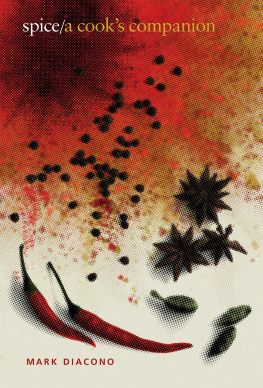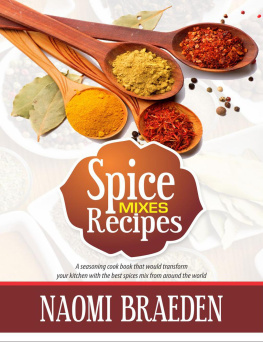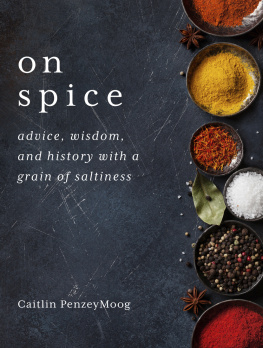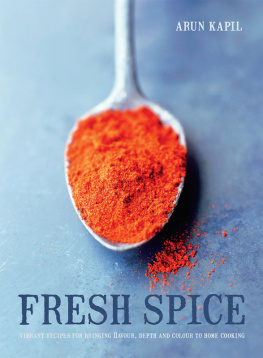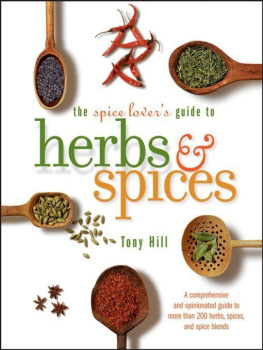THE
FLAVOUR
OF
SPICE
Journeys, Recipes, Stories
Marryam H. Reshii

First published in India in 2017 by Hachette India
(Registered name: Hachette Book Publishing India Pvt. Ltd)
An Hachette UK company
www.hachetteindia.com

This ebook published in 2017
Copyright 2017 Marryam H. Reshii
Marryam H. Reshii asserts the moral right to be identified as the author of this work
All rights reserved. No part of the publication may be copied, reproduced, downloaded, stored in a retrieval system, or transmitted in any form or by any means without the prior written permission of the publisher, nor be otherwise circulated in any form of binding or cover or digital format other than that in which it is published and without a similar condition being imposed on the subsequent purchaser.
Hardback edition ISBN 978-93-5009-908-7
Ebook edition ISBN 978-93-5009-909-4
Cover image Getty Images
Cover design by Haitenlo Semy
Originally typeset in Cardo Regular by SRYA, New Delhi
Hachette Book Publishing India Pvt. Ltd
4th/5th Floors, Corporate Centre
Plot No. 94, Sector 44, Gurgaon 122003, India
To Hafeez, the love of my life
CONTENTS
M y love affair with spices started at the unlikeliest of places: the funeral of a close friends brother. I was at the friends place, helping out with the unending stream of visitors who had come to pay their last respects, when she turned to me and said that lunch a humble khichdi was being served in the next room. Then, with an apologetic grimace, she added, Only thing, it doesnt have any spices. Because we are in mourning. Thats when I had my epiphany: Indian food is so inextricably interwoven with spices that not only is one unthinkable without the other but the sign of being in mourning is to abjure spices. Until then, I had been more or less indifferent about the world of spices and their exact role in our cuisine. But once my interest was piqued, there was no turning back.
A millennium ago, the term Indian spices didnt mean what it does today. For instance, chillies which in the eyes of the world are most commonly associated with Indian food only came to our shores approximately 450 years ago. Not to mention spices like coriander and fenugreek, which came from Egypt and Greece respectively, as well as nigella seeds, mustard seeds, cloves, cinnamon, nutmeg and mace. India has taken all of these and a host of others and incorporated them in supremely sophisticated ways into its regional cuisines, even going on to become the largest producer and consumer of spices in the world. Not for us the use of a single spice as a top-note in a coulis on a plate of panna cotta. Every single dish, from main courses like the Dogri khatta meat to desserts like payasam and halwa, is bathed in a medley of spice, to the extent that it is the spice that defines a dish rather than the main ingredient. Not even accompaniments like yogurt have escaped the touch of spice, often flavoured with dark-roasted cumin, black cardamom or asafoetida, as any street-food seller will tell you. Youll even find them in every Indian sweet shop, in the golden yellow of the laddoos made with sesame and khoya and flavoured with a touch of saffron, or in the scent of green cardamom that permeates the milk-based confections.
Indian cooking plays with spices in a manner that is unparalleled anywhere else in the world. Some spices are roasted before being used, others are pounded finely or coarsely depending on the recipe. Spices are used for tempering right at the end of cooking, or at the very beginning. They can be dry-ground or pulverized with other ingredients like coconut. They can be flashed in smoking-hot oil for just a second or sauted for half-an-hour over low simmering heat.
In fact, spices are so integral to our culture that theyve moved out of our kitchens and into every aspect of our daily lives. Go to the chemist to buy a winter tonic and youll be given a jar of Chyawanprash. The gooey brown paste tastes like an oriental Christmas cake, laden as it is with quite as many aromatic spices as a plum pudding: cinnamon, cloves, cardamom and long pepper. Also at the chemists are several spices lurking on shelves, disguised as other products. If you want to rid yourself of acne, use a well-known brand of cream that contains turmeric. If you dream of becoming a few shades fairer, there are several products that contain saffron to fulfil your desire. Want sparkling pearly whites? Use a toothpaste that has clove oil in it.
On your way back to the car from the chemists, stop for a paan; it will probably contain a silver-coated green cardamom and will be pierced with a clove to keep it firmly folded. Your car, being brand new, has a swastik sign on the bonnet. It has been made with a slurry of turmeric and water and signifies good luck the golden yellow of the turmeric in itself an auspicious colour. Check into a spa today and its likely that the body scrub being used contains black pepper, turmeric and fennel. At home, too, you can treat your spice rack as an instant-remedy counter. If you suffer from a cold, cough or indigestion, there is no need to look beyond your kitchen.
Considering how all-pervasive spices are, it is rather surprising how little is known about them. Ask the average grocer anywhere in the country where the cumin he is selling comes from and hell answer with a bored shrug. Ask a spice seller where the large, carmine chilli at his store comes from and unhesitatingly hell reply Kashmir. Actually it doesnt, because what is called Kashmiri in the market is usually grown from seeds that, at some point, originated in Kashmir, but have been grown for years, if not decades, in Karnataka and Andhra Pradesh.
It has always surprised me that schoolchildren are taught about the crops that grow in each state but never learn about spices, although some spices are extremely important crops in the states where they are cultivated. Even state maps resolutely avoid the smallest mention of spices. They list every agricultural crop, from pulses to grains to flowers and vegetables, but none of them touches upon spices. I find this utterly confounding. (Or, perhaps, looked at from another perspective, it is fitting, since spices are like secret ingredients that are added to lentils, lamb or rice, turning them into dishes fit for kings.) One thing is for sure: Theres little literature from within the country about our spices and their provenance, and that which does exist tends to be written with all the passion of a textbook.
So how is it that India has co-opted spices that came from all over the world and integrated them so seamlessly with the host of regional cuisines that exist within its borders? At what point in history did this trade take place? How did the spices that we see on our plates today come to be grown in India? I have been intrigued by these questions for years, and the more I have delved into the spice story, the more fascinated I have become.
One aspect in particular that I have found no apparent answer to is the provenance of a spice versus its use. Take Kashmir, for instance. It might be the only place where saffron grows in India, but Kashmiri cuisine uses insignificant amounts of saffron, whereas the predominantly vegetarian states of Gujarat and Rajasthan use the spice generously in their fare. Or take West Bengal. It is one of the largest users of poppy seeds in the country, which grows nowhere near its borders. Just how did spices travel from one corner of the country to the other? How was it that turmeric from Tamil Nadu and fennel from the fields of Uttar Pradesh (UP) made their way to the very north, to Kashmir?
Next page


